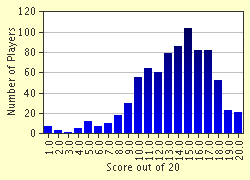Quiz Answer Key and Fun Facts
1. Which is the best phrase that explains Albert Einstein's famous equation regarding relativity, 'E equals m times c squared'?
2. Roger Bacon is often called the 'Father of Modern Science' for what reason?
3. In 1242 A.D., Roger Bacon discovered that black powder (gunpowder) would explode rather than simply burn if he did what?
4. The Swedish scientist Alfred Nobel is most famous today for creating the Nobel Prize. What invention made him rich?
5. In 1828, Friedrich Woehler performed the first chemical synthesis of a naturally occurring biologic (organic) molecule. What did he synthesize?
6. In 1660, Robert Boyle discovered what revolutionary finding about gases?
7. The 19th century Russian chemist Dmitri Mendeleyev arranged cards that described all known chemical elements into what?
8. The German scientist Max Planck was the first to suggest that classical laws of physics did not always apply to atomic systems. By studying light of different frequencies, he proposed the existence of quanta that carried discrete but small amounts of what?
9. Around 300 B.C.E., Theophrastus, one of Aristotle's students, first described asbestos as 'a substance resembling rotting wood which, when doused with oil, would burn without being harmed.' Where does asbestos come from?
10. At the end of the 19th century, Fritz Haber first synthesized ammonia from nitrogen and hydrogen. This was important to the world population because:
11. In 1775, Benjamin Franklin traveled from England to America on a sailing ship. He measured the temperature of the water with a thermometer at many points during the voyage and thus discovered a region of warm water due to what?
12. The Scottish botanist Robert Brown first observed the process now known as Brownian movement in 1827. What is it?
13. In 1858, Charles Darwin proposed what theory to explain the diversity of living things on earth?
14. In 1803, John Dalton proposed that all substances are composed of small, dense, indestructible particles known as what?
15. From carefully weighing the reactants and products of chemical reactions, the 18th century French chemist Antoine Lavoisier laid the groundwork for what fundamental scientific principle?
16. In 1932, James Chadwick discovered what subatomic particle that contains mass but no charge?
17. Galileo's famous experiment at the leaning tower of Pisa demonstrated what about gravity?
18. The 'two body problem' was first solved by:
19. Why was Galileo's book "Dialogue Concerning the Two Chief World Systems", published in 1632, banned by an Inquisition conducted by the Catholic Church year later?
20. Werner Heisenberg enunciated his 'uncertainty principle' in 1927. It states that:
Source: Author
dr_vitz
This quiz was reviewed by FunTrivia editor
bloomsby before going online.
Any errors found in FunTrivia content are routinely corrected through our feedback system.

